University Macroeconomics Assignment on Banking and Monetary Policy
VerifiedAdded on 2020/04/13
|6
|1075
|49
Homework Assignment
AI Summary
This macroeconomics assignment addresses key concepts related to money, banking, and financial systems. The assignment begins with multiple-choice questions on fundamental macroeconomic principles, such as the functions of money, definitions of M1 and M2, and the concept of a store of value. The core of the assignment involves an in-depth analysis of the Egyptian banking sector, examining its evolution since the mid-1970s, its structure, and the impact of government policies. It discusses the different types of banks operating in Egypt, their roles, and the challenges they face, including issues related to loanable funds, market competition, and the under-penetration of banking services. The assignment also reviews the Central Bank of Egypt's initiatives, such as the introduction of mini-branches, and the impact of government debt programs. It concludes with a discussion on the need for regulatory frameworks, transparency, corporate governance, and market disciplines to strengthen the Egyptian banking sector.
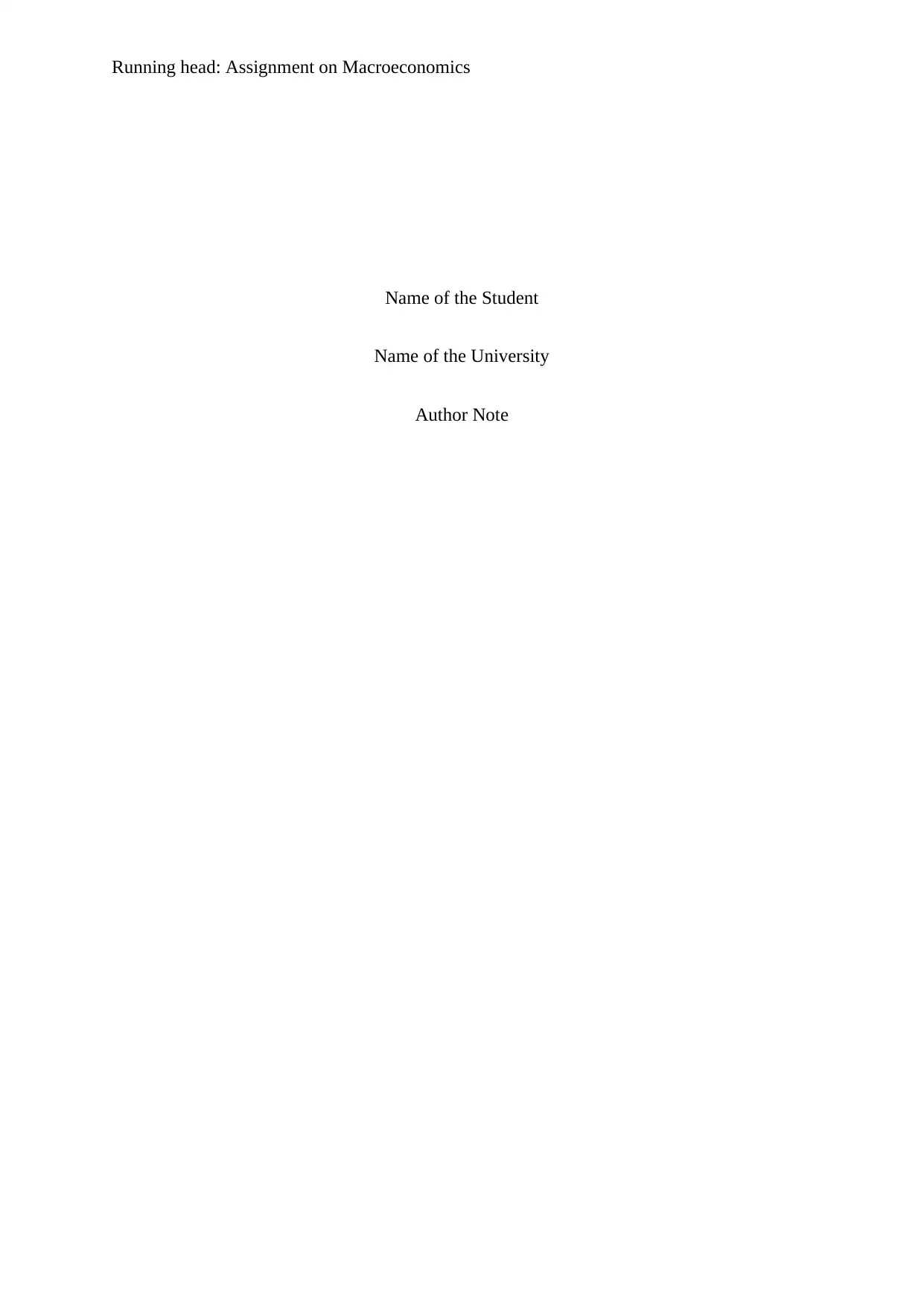
Running head: Assignment on Macroeconomics
Name of the Student
Name of the University
Author Note
Name of the Student
Name of the University
Author Note
Paraphrase This Document
Need a fresh take? Get an instant paraphrase of this document with our AI Paraphraser
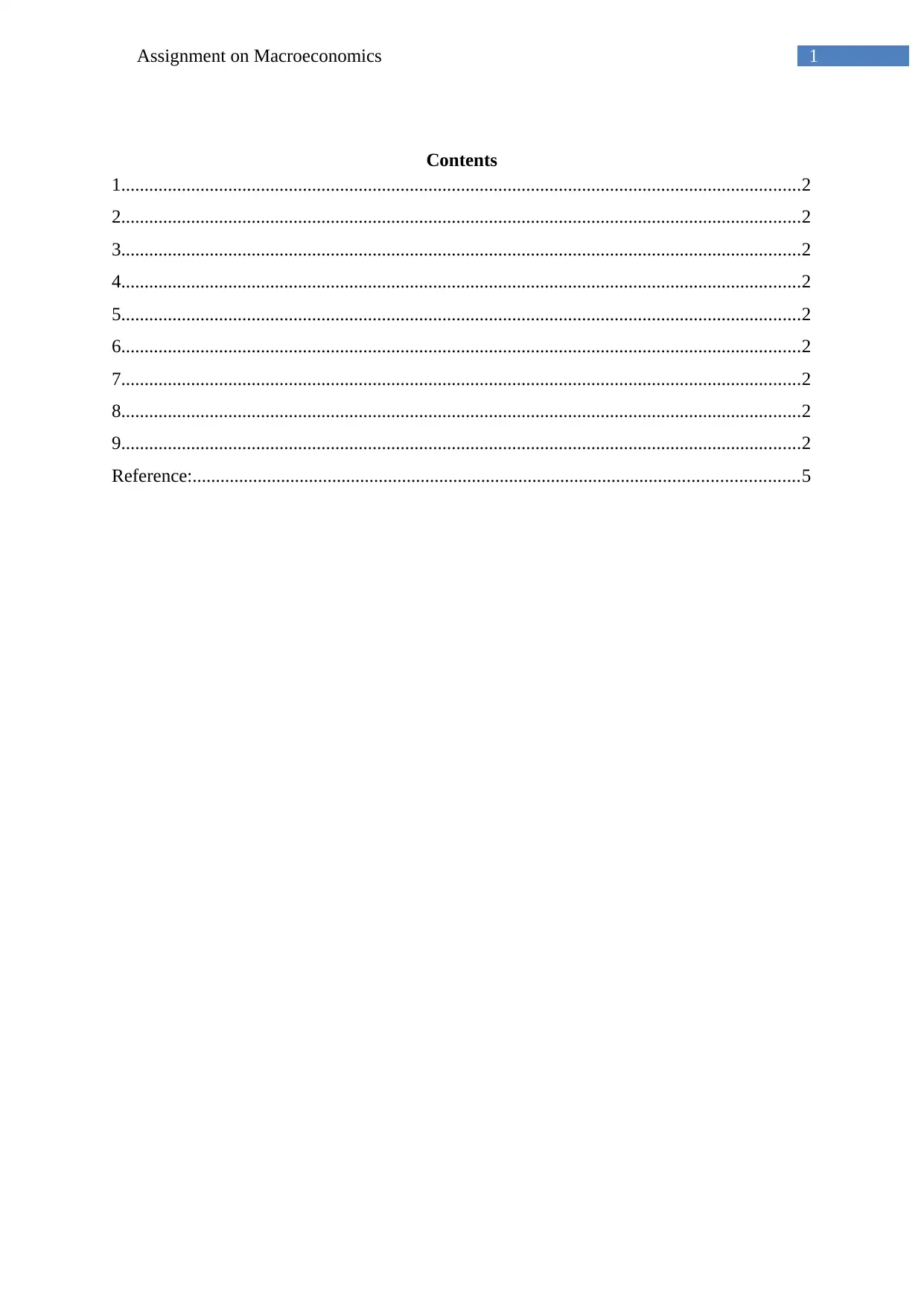
1Assignment on Macroeconomics
Contents
1..................................................................................................................................................2
2..................................................................................................................................................2
3..................................................................................................................................................2
4..................................................................................................................................................2
5..................................................................................................................................................2
6..................................................................................................................................................2
7..................................................................................................................................................2
8..................................................................................................................................................2
9..................................................................................................................................................2
Reference:..................................................................................................................................5
Contents
1..................................................................................................................................................2
2..................................................................................................................................................2
3..................................................................................................................................................2
4..................................................................................................................................................2
5..................................................................................................................................................2
6..................................................................................................................................................2
7..................................................................................................................................................2
8..................................................................................................................................................2
9..................................................................................................................................................2
Reference:..................................................................................................................................5
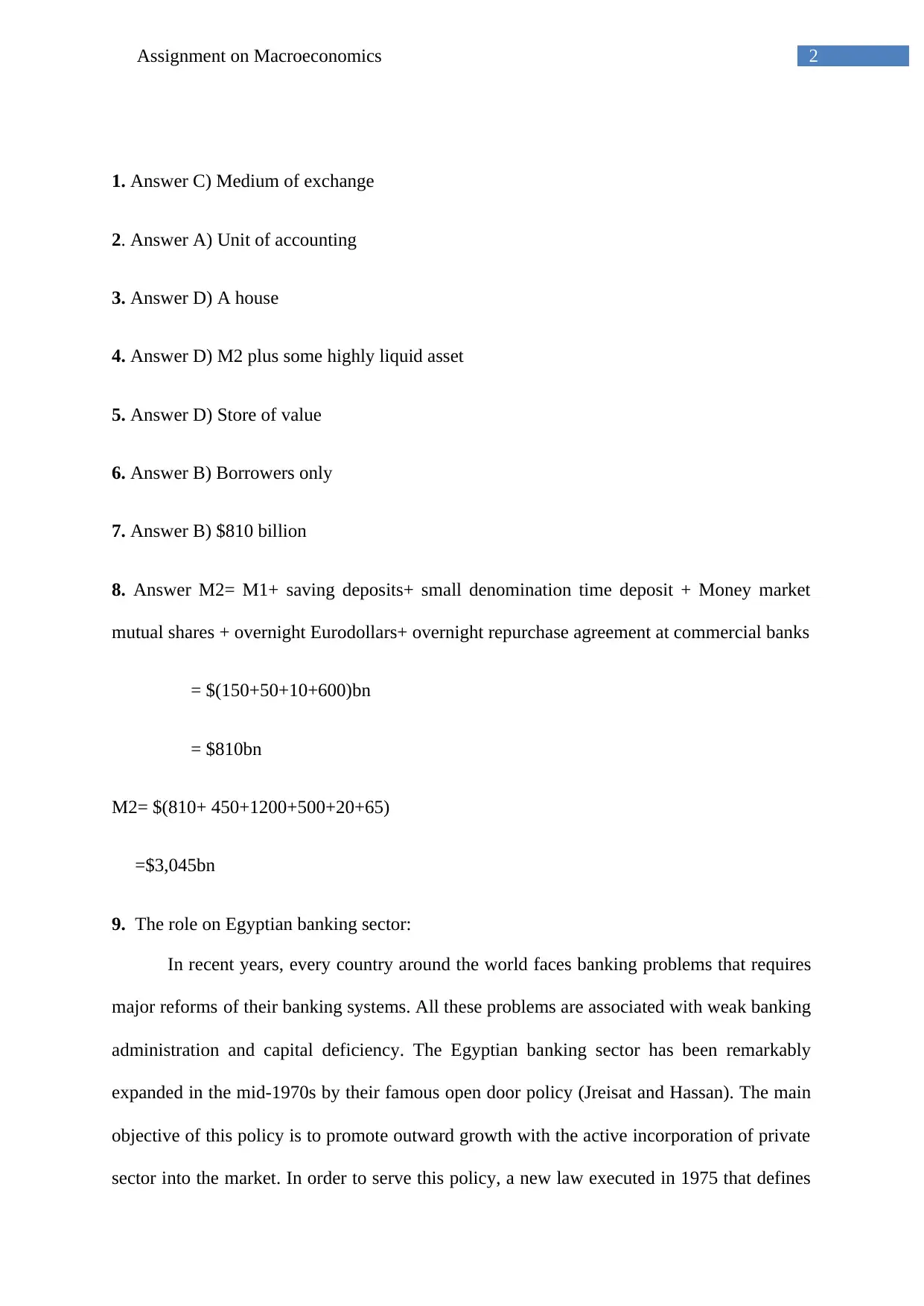
2Assignment on Macroeconomics
1. Answer C) Medium of exchange
2. Answer A) Unit of accounting
3. Answer D) A house
4. Answer D) M2 plus some highly liquid asset
5. Answer D) Store of value
6. Answer B) Borrowers only
7. Answer B) $810 billion
8. Answer M2= M1+ saving deposits+ small denomination time deposit + Money market
mutual shares + overnight Eurodollars+ overnight repurchase agreement at commercial banks
= $(150+50+10+600)bn
= $810bn
M2= $(810+ 450+1200+500+20+65)
=$3,045bn
9. The role on Egyptian banking sector:
In recent years, every country around the world faces banking problems that requires
major reforms of their banking systems. All these problems are associated with weak banking
administration and capital deficiency. The Egyptian banking sector has been remarkably
expanded in the mid-1970s by their famous open door policy (Jreisat and Hassan). The main
objective of this policy is to promote outward growth with the active incorporation of private
sector into the market. In order to serve this policy, a new law executed in 1975 that defines
1. Answer C) Medium of exchange
2. Answer A) Unit of accounting
3. Answer D) A house
4. Answer D) M2 plus some highly liquid asset
5. Answer D) Store of value
6. Answer B) Borrowers only
7. Answer B) $810 billion
8. Answer M2= M1+ saving deposits+ small denomination time deposit + Money market
mutual shares + overnight Eurodollars+ overnight repurchase agreement at commercial banks
= $(150+50+10+600)bn
= $810bn
M2= $(810+ 450+1200+500+20+65)
=$3,045bn
9. The role on Egyptian banking sector:
In recent years, every country around the world faces banking problems that requires
major reforms of their banking systems. All these problems are associated with weak banking
administration and capital deficiency. The Egyptian banking sector has been remarkably
expanded in the mid-1970s by their famous open door policy (Jreisat and Hassan). The main
objective of this policy is to promote outward growth with the active incorporation of private
sector into the market. In order to serve this policy, a new law executed in 1975 that defines
⊘ This is a preview!⊘
Do you want full access?
Subscribe today to unlock all pages.

Trusted by 1+ million students worldwide
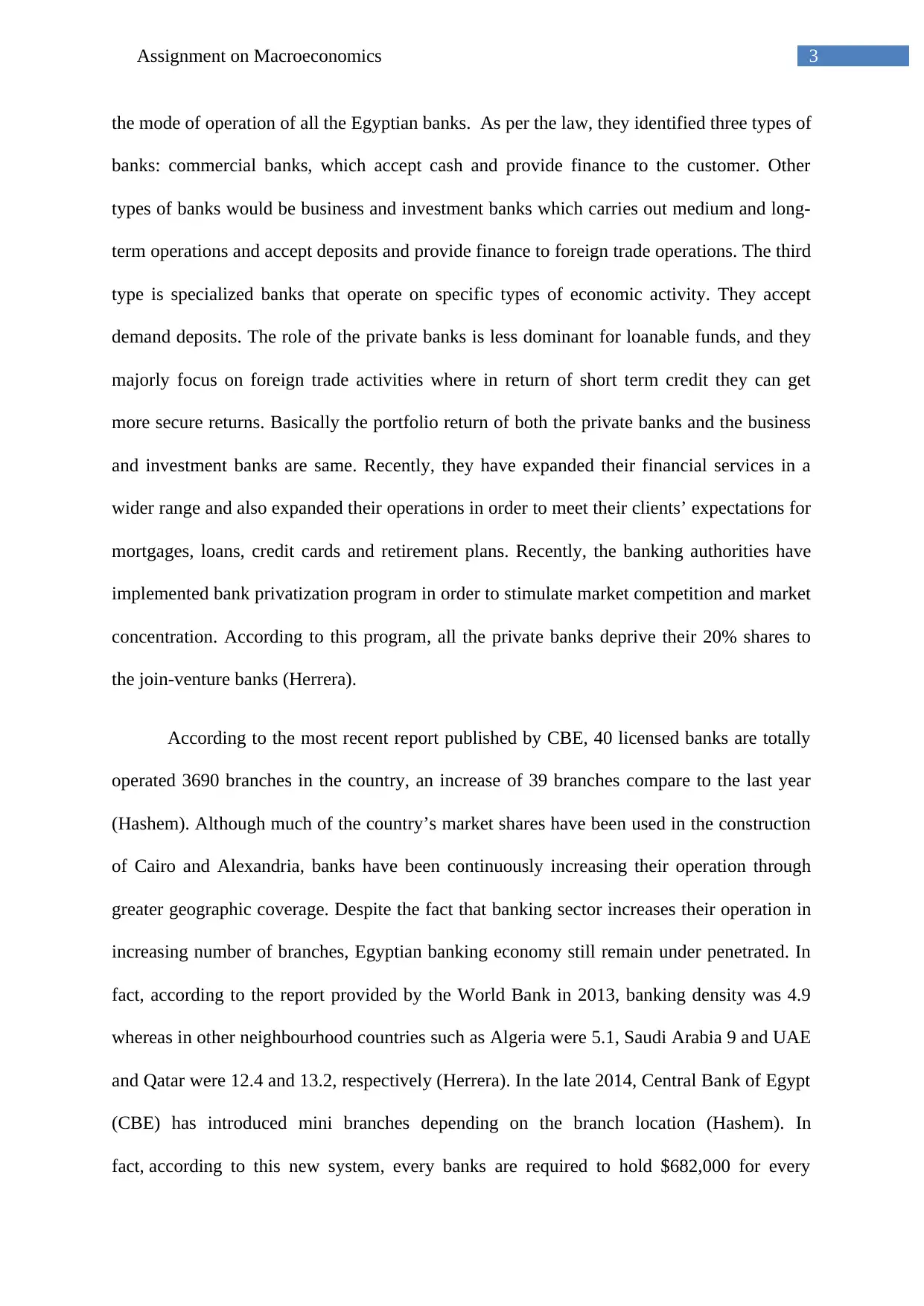
3Assignment on Macroeconomics
the mode of operation of all the Egyptian banks. As per the law, they identified three types of
banks: commercial banks, which accept cash and provide finance to the customer. Other
types of banks would be business and investment banks which carries out medium and long-
term operations and accept deposits and provide finance to foreign trade operations. The third
type is specialized banks that operate on specific types of economic activity. They accept
demand deposits. The role of the private banks is less dominant for loanable funds, and they
majorly focus on foreign trade activities where in return of short term credit they can get
more secure returns. Basically the portfolio return of both the private banks and the business
and investment banks are same. Recently, they have expanded their financial services in a
wider range and also expanded their operations in order to meet their clients’ expectations for
mortgages, loans, credit cards and retirement plans. Recently, the banking authorities have
implemented bank privatization program in order to stimulate market competition and market
concentration. According to this program, all the private banks deprive their 20% shares to
the join-venture banks (Herrera).
According to the most recent report published by CBE, 40 licensed banks are totally
operated 3690 branches in the country, an increase of 39 branches compare to the last year
(Hashem). Although much of the country’s market shares have been used in the construction
of Cairo and Alexandria, banks have been continuously increasing their operation through
greater geographic coverage. Despite the fact that banking sector increases their operation in
increasing number of branches, Egyptian banking economy still remain under penetrated. In
fact, according to the report provided by the World Bank in 2013, banking density was 4.9
whereas in other neighbourhood countries such as Algeria were 5.1, Saudi Arabia 9 and UAE
and Qatar were 12.4 and 13.2, respectively (Herrera). In the late 2014, Central Bank of Egypt
(CBE) has introduced mini branches depending on the branch location (Hashem). In
fact, according to this new system, every banks are required to hold $682,000 for every
the mode of operation of all the Egyptian banks. As per the law, they identified three types of
banks: commercial banks, which accept cash and provide finance to the customer. Other
types of banks would be business and investment banks which carries out medium and long-
term operations and accept deposits and provide finance to foreign trade operations. The third
type is specialized banks that operate on specific types of economic activity. They accept
demand deposits. The role of the private banks is less dominant for loanable funds, and they
majorly focus on foreign trade activities where in return of short term credit they can get
more secure returns. Basically the portfolio return of both the private banks and the business
and investment banks are same. Recently, they have expanded their financial services in a
wider range and also expanded their operations in order to meet their clients’ expectations for
mortgages, loans, credit cards and retirement plans. Recently, the banking authorities have
implemented bank privatization program in order to stimulate market competition and market
concentration. According to this program, all the private banks deprive their 20% shares to
the join-venture banks (Herrera).
According to the most recent report published by CBE, 40 licensed banks are totally
operated 3690 branches in the country, an increase of 39 branches compare to the last year
(Hashem). Although much of the country’s market shares have been used in the construction
of Cairo and Alexandria, banks have been continuously increasing their operation through
greater geographic coverage. Despite the fact that banking sector increases their operation in
increasing number of branches, Egyptian banking economy still remain under penetrated. In
fact, according to the report provided by the World Bank in 2013, banking density was 4.9
whereas in other neighbourhood countries such as Algeria were 5.1, Saudi Arabia 9 and UAE
and Qatar were 12.4 and 13.2, respectively (Herrera). In the late 2014, Central Bank of Egypt
(CBE) has introduced mini branches depending on the branch location (Hashem). In
fact, according to this new system, every banks are required to hold $682,000 for every
Paraphrase This Document
Need a fresh take? Get an instant paraphrase of this document with our AI Paraphraser
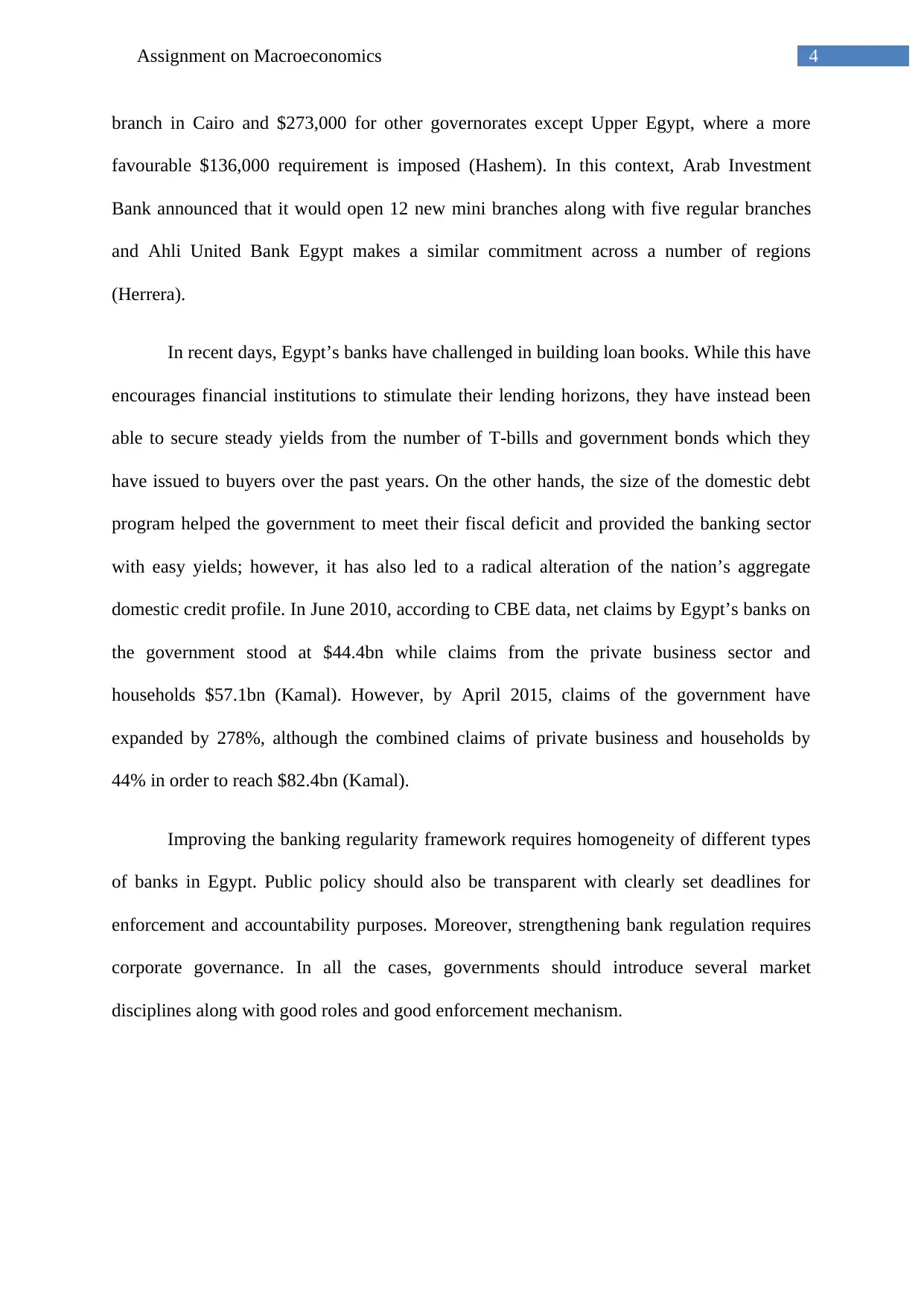
4Assignment on Macroeconomics
branch in Cairo and $273,000 for other governorates except Upper Egypt, where a more
favourable $136,000 requirement is imposed (Hashem). In this context, Arab Investment
Bank announced that it would open 12 new mini branches along with five regular branches
and Ahli United Bank Egypt makes a similar commitment across a number of regions
(Herrera).
In recent days, Egypt’s banks have challenged in building loan books. While this have
encourages financial institutions to stimulate their lending horizons, they have instead been
able to secure steady yields from the number of T-bills and government bonds which they
have issued to buyers over the past years. On the other hands, the size of the domestic debt
program helped the government to meet their fiscal deficit and provided the banking sector
with easy yields; however, it has also led to a radical alteration of the nation’s aggregate
domestic credit profile. In June 2010, according to CBE data, net claims by Egypt’s banks on
the government stood at $44.4bn while claims from the private business sector and
households $57.1bn (Kamal). However, by April 2015, claims of the government have
expanded by 278%, although the combined claims of private business and households by
44% in order to reach $82.4bn (Kamal).
Improving the banking regularity framework requires homogeneity of different types
of banks in Egypt. Public policy should also be transparent with clearly set deadlines for
enforcement and accountability purposes. Moreover, strengthening bank regulation requires
corporate governance. In all the cases, governments should introduce several market
disciplines along with good roles and good enforcement mechanism.
branch in Cairo and $273,000 for other governorates except Upper Egypt, where a more
favourable $136,000 requirement is imposed (Hashem). In this context, Arab Investment
Bank announced that it would open 12 new mini branches along with five regular branches
and Ahli United Bank Egypt makes a similar commitment across a number of regions
(Herrera).
In recent days, Egypt’s banks have challenged in building loan books. While this have
encourages financial institutions to stimulate their lending horizons, they have instead been
able to secure steady yields from the number of T-bills and government bonds which they
have issued to buyers over the past years. On the other hands, the size of the domestic debt
program helped the government to meet their fiscal deficit and provided the banking sector
with easy yields; however, it has also led to a radical alteration of the nation’s aggregate
domestic credit profile. In June 2010, according to CBE data, net claims by Egypt’s banks on
the government stood at $44.4bn while claims from the private business sector and
households $57.1bn (Kamal). However, by April 2015, claims of the government have
expanded by 278%, although the combined claims of private business and households by
44% in order to reach $82.4bn (Kamal).
Improving the banking regularity framework requires homogeneity of different types
of banks in Egypt. Public policy should also be transparent with clearly set deadlines for
enforcement and accountability purposes. Moreover, strengthening bank regulation requires
corporate governance. In all the cases, governments should introduce several market
disciplines along with good roles and good enforcement mechanism.
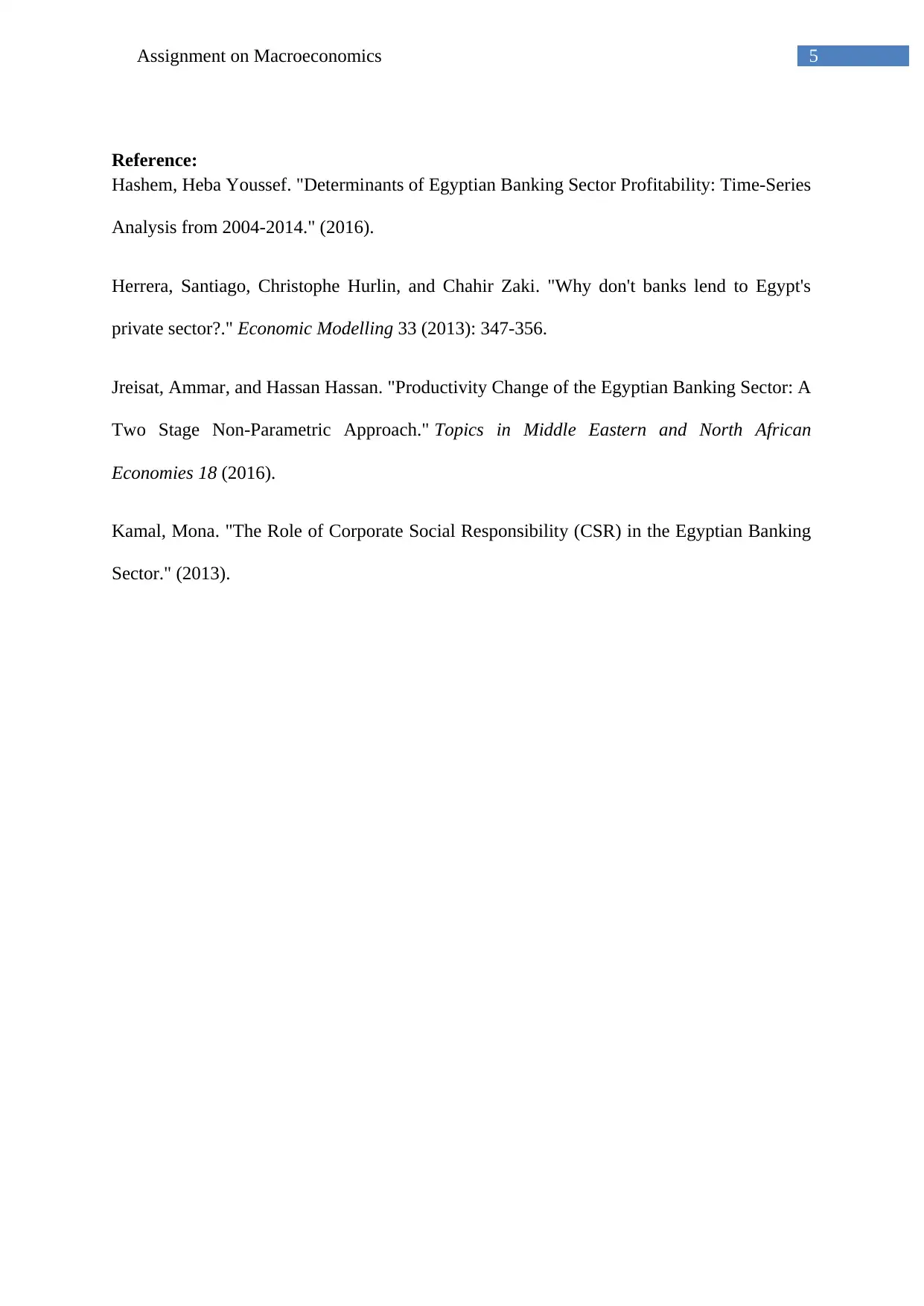
5Assignment on Macroeconomics
Reference:
Hashem, Heba Youssef. "Determinants of Egyptian Banking Sector Profitability: Time-Series
Analysis from 2004-2014." (2016).
Herrera, Santiago, Christophe Hurlin, and Chahir Zaki. "Why don't banks lend to Egypt's
private sector?." Economic Modelling 33 (2013): 347-356.
Jreisat, Ammar, and Hassan Hassan. "Productivity Change of the Egyptian Banking Sector: A
Two Stage Non-Parametric Approach." Topics in Middle Eastern and North African
Economies 18 (2016).
Kamal, Mona. "The Role of Corporate Social Responsibility (CSR) in the Egyptian Banking
Sector." (2013).
Reference:
Hashem, Heba Youssef. "Determinants of Egyptian Banking Sector Profitability: Time-Series
Analysis from 2004-2014." (2016).
Herrera, Santiago, Christophe Hurlin, and Chahir Zaki. "Why don't banks lend to Egypt's
private sector?." Economic Modelling 33 (2013): 347-356.
Jreisat, Ammar, and Hassan Hassan. "Productivity Change of the Egyptian Banking Sector: A
Two Stage Non-Parametric Approach." Topics in Middle Eastern and North African
Economies 18 (2016).
Kamal, Mona. "The Role of Corporate Social Responsibility (CSR) in the Egyptian Banking
Sector." (2013).
⊘ This is a preview!⊘
Do you want full access?
Subscribe today to unlock all pages.

Trusted by 1+ million students worldwide
1 out of 6
Related Documents
Your All-in-One AI-Powered Toolkit for Academic Success.
+13062052269
info@desklib.com
Available 24*7 on WhatsApp / Email
![[object Object]](/_next/static/media/star-bottom.7253800d.svg)
Unlock your academic potential
Copyright © 2020–2025 A2Z Services. All Rights Reserved. Developed and managed by ZUCOL.





